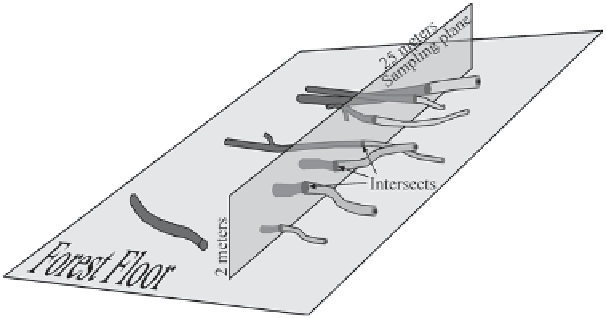Agriculture Reference
In-Depth Information
Fig. 8.1
Illustration showing the sampling of fuel particles using the planar intercept method
8.3.2
Direct Methods
These methods involve directly sampling or measuring characteristics of fuel par-
ticles to calculate loading. This usually involves direct contact with the fuel, such
as measuring dimensions of particles using calipers, estimating depths of duff and
litter using rulers, or collecting particles for drying and weighing in the lab.
8.3.2.1
Planar Intercept (PI)
PI
techniques are the most commonly used sampling methods for sampling downed
woody fuels for both management and research (Catchpole and Wheeler
1992
;
Dibble and Rees
2005
) and both inventory and monitoring projects (Busing et al.
2000
; Waddell
2001
). PI sampling involves counting woody fuel particles by di-
ameter size classes, or by directly measuring individual particle diameters, as they
intercept a vertical sampling plane that is of a fixed length and height (Brown
1970
,
1974
; Fig.
8.1
). These intercepts are then converted to loadings using standard for-
mulae (Brown
1974
). There are correction factors for the slope of the sampling
plane and orientation of the fuel particles. One major parameter for computing load-
ing is the particle density (specific gravity) of the particles (Table 2.1; Chap. 2).
PI is the operational version of the line transect method originally introduced by
Warren and Olsen (
1964
) and made applicable for measuring CWD by Van Wagner
(
1968
). The line transect method is founded in the probability-proportional-to-size
concepts and several variations of it have been developed since 1968, including
those that vary the transect arrangements and directions, and those that apply the
technique using different technologies (Hansen
1985
; Nemec-Linnell and Davis
2002
; Vries
1974
). Brown (
1971
) modified the line transect method so that particle
intercepts are measured in a two-dimensional plane rather than a one-dimensional

Search WWH ::

Custom Search